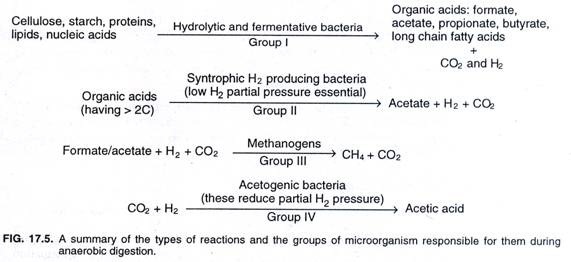biogas production
Role of Microorganisms in Biogas Production (Explained With Diagram)!
Several hundred species of microorganisms are involved in the anaerobic digestion and biogas production. These bacteria can be divided into the following four trophic groups: (i) hydrolytic and fermentative bacteria, (ii) syntrophic H2 producing bacteria, (iii) methanogenic bacteria and (iv) acetogenic bacteria.
Hydrolytic and Fermentative Bacteria:
This group includes both obligate and facultative anaerobes, and may occur up to 108-109cells/ml of sewage sludge digesters. They remove the small amounts of O2 present and create anaerobic conditions. These bacteria hydrolyze and ferment the organic materials, e.g., cellulose, starch, proteins, sugars, lipids, etc., and produce organic acids, CO2 and H2(Fig. 17.5).
Digestion of complex polysaccharides is rate-limiting, and the lignin associated with cellulose often shields the latter from enzyme action. Therefore, usually, only 50% of the polysaccharides present in the waste may be digested.
Syntrophic H2 Producing Bacteria:
This group is also called obligate H2 producing or obligate proton reducing bacteria since they oxidise NADH by reducing H+ to H2, and, thereby, produce hydrogen. These bacteria breakdown organic acids having greater than 2 carbon atoms in their chain to produce acetate, CO2 and H2.
However, they are able to grow freely and produce H2 only under low H2 partial pressure, which is maintained by methanogens. Sewage sludge digesters have about 4 x 106 cells/ml of this group. Examples of these bacteria are Syntrophomonas wolfei, and S. wolinii.
Methanogenic Bacteria:
This group of bacteria converts acetate, and CO2 + H2 into methane. Thus methanogens remove the H2 produced by obligate H2-producing bacteria, thereby, lowering the H2partial pressure and enabling the latter to continue producing H2. Methanogenic bacteria are the strictest possible anaerobes known. They may occur upto 106-108 cell/ml of the slurry in digesters. These belong to the new kingdom called Archaebacteria and oxidise H2by reducing C02 to obtain energy (see below).
4H2 4- CO2 -4 CH4 + 2H2O
(∆G0 = -139 kJ/mol)
Examples of methanogenic bacteria are Methanosarcina barkeri, Methanobacterium omelianskii, etc.
Acetogenic Bacteria:
These bacteria oxidise H2 by reducing CO2 to acetic acid, which is then used up by methanogens to generate methane, CO2 and H2. Thus acetogenic bacteria also remove H2and enable the obligate H2 producing bacteria to continue their function.


